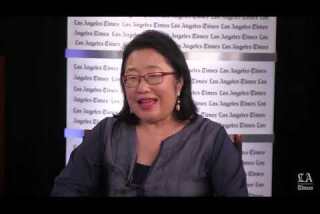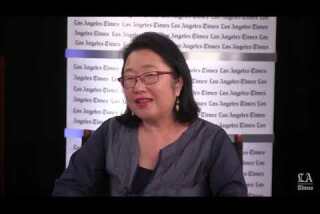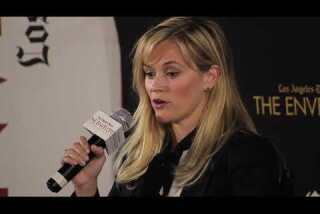The ‘Ishtar’ effect: When a film flops and its female director never works again
- Share via
As a viewer, I greet the arrival of a new film directed by a woman with anticipation. I love Nancy Meyers’ intrepid heroines and Kathryn Bigelow’s tense set pieces and Ava DuVernay’s human moments. Would a male director have shown us the Rev. Martin Luther King Jr. bagging the kitchen garbage, as DuVernay did in “Selma?” Maybe, but probably not.
Watching a movie directed by a woman, I assume I’ll be spared certain annoyances — long tracking shots of a supermodel’s butt, 20 minutes spent destroying a computer-generated city, rape scenes shot with the emotional consideration of a car chase.
This month, four very different films directed by women arrive in theaters in wide release — Angelina Jolie-Pitt’s period romance “By the Sea,” Catherine Hardwicke’s female friendship drama “Miss You Already,” Jessie Nelson’s Christmas comedy “Love the Coopers” and Patricia Riggen’s survival tale “The 33.” In an industry where, according to research conducted by The Times, USC and others, only 4% of studio films are directed by women, this should be an indicator of a positive counter-trend, a fist-bump-worthy, feminist moment in cinema.
SIGN UP for the free Indie Focus movies newsletter >>
So why instead do I feel so queasy?
Because we’ve had such moments before, and the way previous generations of female directors have fared makes me wary of any premature celebrations. Women, from silent-film-era trailblazer Lois Weber to 1970s and ‘80s comedy auteur Elaine May to Hardwicke herself after she directed the 2008 box office hit “Twilight,” have been subjected to higher standards and lower rewards than their male peers in Hollywood.
Once female directors get the job, the potential roadblocks to career advancement are numerous and varied and include studio expectations, the critical establishment and peer networks.
Consider that when Hardwicke, who made back more than 10 times her production budget on “Twilight,” asked for more time to work on the sequel, she was replaced, while the maker of another wildly profitable fantasy film, “Avatar’s” James Cameron, has been allowed to push back the timeline for his sequels repeatedly.
Hollywood’s gender gap


Hollywood's gender gap | The few, the proud: female directors

Hollywood's gender gap | Why not a woman?

Hollywood's gender gap | A female director is...

Hollywood's gender gap | If I had $200 million...

'Wild' - Women Filmmakers
May, who took the fall for the legendary 1987 Warren Beatty-Dustin Hoffman comedy “Ishtar,” never directed again after the box office flop. The film’s two actor-producers, who shared final cut with her, emerged unscathed, with Beatty going on to make “Dick Tracy” and Hoffman “Rain Man.”
“A male director can have a series of failures and still get hired,” Anne Hathaway said to me last summer when I interviewed her and Meyers for a story about their movie, “The Intern.” “Sometimes movies don’t work, and I feel like if it stars a woman or is directed by a woman, the wheels can’t fall off the train. If this movie directed by a woman does well and this movie directed by a woman does well and then one doesn’t, it’s ‘oh, people don’t like movies directed by women.’”
Put another way, as “Punisher: War Zone” director Lexi Alexander did on Twitter after new movies directed by David Gordon Green, Christopher Landon and John Wells performed lethargically at the box office over the Halloween weekend, “This was a bad weekend for white, male directors. How will they ever find work again?”
Hollywood’s low rate of hiring female directors in film and television has come under new scrutiny, thanks to an Equal Employment Opportunity Commission investigation launched in October. Urged by the American Civil Liberties Union, the EEOC has begun interviewing female directors about their experiences.
But even when a woman gets hired for a first film, she faces barriers to a long, productive career. Of the movies that secure distribution deals at the Sundance Film Festival, those directed by men are picked up by bigger companies with deeper pockets, according to research conducted by USC’s Media, Diversity and Social Change Initiative.
Of the Sundance filmmakers who reach the widest platform of theatrical distribution — above 250 screens — male directors outnumber female directors 6-1. How can female directors establish the box office track record supposedly required to get hired on big studio movies if their films screen for fewer people to begin with?
Once women’s movies are up on those screens, there’s yet another hurdle: film critics and bloggers, who are overwhelmingly male. Speaking last month at a news conference for her new film, “Suffragette,” directed by a woman (Sarah Gavron), Meryl Streep called the disparity “infuriating.”
“Men and women are not the same,” Streep said, pointing out that she’d found 168 women contributing to Rotten Tomatoes scores (a group that includes me) and 760 men. “They like different things. Sometimes they like the same things, but their tastes diverge. If the Tomatometer is slided so completely to one set of tastes, that drives box office in the U.S., absolutely.”
Film critics, and even more so film bloggers, describe detail-oriented male directors like David Fincher and Cameron as idiosyncratic visual geniuses while dismissing Meyers, who applies a similarly painstaking approach to vivid interiors in pictures such as “It’s Complicated” and “The Intern,” as a purveyor of middlebrow chick flicks.
When a female director manages to step up from independent to studio filmmaking and win over critics, as DuVernay did with “Selma,” the potentially career-changing event of awards season brings still another barrier — her peers. Though “Selma” collected rave reviews and a best picture nomination, DuVernay, an African American woman, was not nominated for best director by her branch of the film academy, which is 90% white and 91% male, according to a 2012 Times analysis.
“I know not one person in my branch,” DuVernay told Entertainment Weekly last year. In a recent interview with blogger Anne Thompson, director Quentin Tarantino said he still hadn’t seen “Selma.” A movie nominated for best picture, and nearly a year after its release, one of the most prominent members of the director’s branch still hadn’t even seen it?
Female directors, writers and producers are often not part of the same social circles as their male counterparts in Hollywood — for women of color like DuVernay, that social exclusion is further amplified.
“If someone doesn’t know you in a social way, they’re less interested in your film,” said the Academy Award-winning producer of “Crash,” Cathy Schulman, who is the president of STX Entertainment and head of the advocacy group Women in Film. “It’s hard to control your own biases. You like what you like and who you like.”
The long-term effect of that unconscious bias is more women dropping out of the film business, because it takes them longer, on average than men to get their next movies financed.
During October, Turner Classic Movies ran 47 pictures directed by women in a programming initiative hosted by Illeana Douglas and made in partnership with Women in Film. The classic film channel screened hard-to-find movies like Weber’s 1921 silent drama “The Blot,” Ida Lupino’s 1950 rape culture classic “Outrage,” Barbara Loden’s 1971 crime drama “Wanda” and Julie Dash’s 1991 African American period drama “Daughters of the Dust.”
“All my research for the older films would end with ‘and she died in obscurity,’” Douglas said about the series. “Why wasn’t she brought back to do more movies? A lot of these women are still here, still available. Pick up the phone and call them and work with them.”
The women whose films open this month will hopefully find more long-term career support than their predecessors did. Certainly, there is no threat of Jolie-Pitt dying in obscurity.
But there is a threat of complacency, of Hollywood and its observers confusing a high-profile woman in a director’s chair with actual systemic change, as many of us did after Bigelow became the first woman to win an Oscar for directing in 2010. What followed instead was five years of stagnation in studio hiring of female directors, an uptick in the number of CG cities destroyed on the big screen and a drop in the number of human moments.
More to Read
Only good movies
Get the Indie Focus newsletter, Mark Olsen's weekly guide to the world of cinema.
You may occasionally receive promotional content from the Los Angeles Times.











